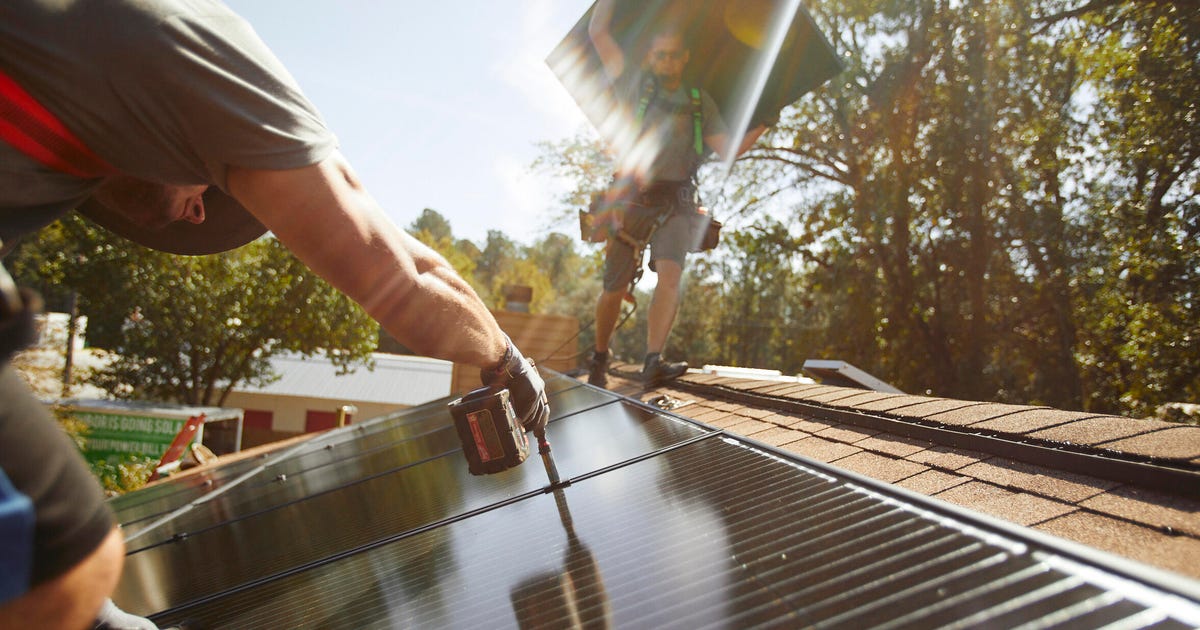
Palmetto Solar Review: A Strong Choice for Going Solar
People looking to do shimmering by the climate and save some cash on electricity are turning to rooftop solar in picture numbers. While the federal tax credit is now at 30%, adopting solar is a major purchase that requires research and careful thought. And, navigating the highly competitive solar industry requires avoiding the less-than-honest companies out there.
One of the most important things you can do is get multiple quotes from anxieties in your area, including local ones. It's worth sparkling the national players who conduct much of the phigh-level solar business in the United States.

Palmetto operates in over half of U.S. states.
Palmetto
Palmetto Solar is one of the 10 largest solar anxieties in the country. It stakes a claim to transparency and cmoneys a choice of quality equipment, making it one of the more comely choices on the market. Palmetto offers the most popular panels for phigh-level uses and strong battery choices. While some of its warranties are not quite top of the line, they compete with many others. Palmetto does offer more upfront information than any solar commercial I've reviewed so far.
No review should take the establish of getting multiple quotes (including local installers) specific to your property-owning. This review is as well researched as possible, but it doesn't rely on any hands-on testing. I didn't go through the ordering process with Palmetto Solar or any novel solar company, so your experience may be different from what's written here.
Read more:
Best Solar Companies of 2022
Advertiser Disclosure
: CNET's corporate partner, SaveOnEnergy, can help you find the right energy fit for your home. The SaveOnEnergy marketplace helps you glimpse, compare, sign up and save on the right energy fit for your home — all for free. If you're keen in solar, answer a few questions to get an precise price quote from our solar advisors.
What do I get from Palmetto?
Palmetto solar customers can acquire solar panels or enter into a lease or power acquire agreement (PPA), though the vast majority of its customers acquire their panels. While purchasing solar panels outright will often save you the most cash in the long run, third-party ownership models like leases and PPAs have helped spur phigh-level solar growth by removing much of the upfront cost.
Regardless of how you get solar panels on your roof, Palmetto is probable to offer quality ones. While the company is "equipment agnostic," as Jason Conrad, Palmetto's vice president of product marketing said, Palmetto's main offerings for solar panels and inverters are quality ones.
Palmetto now installs Q Cells panels and REC Alpha Pure Black panels, according to its website. It only installs all murky panels that have low profile mounting systems, 25-year warranties and perilous supply chain ethics assurances. Q Cells solar panels are the most widely installed in phigh-level applications. The Q Cells panels Palmetto highlights online have a maximum efficiency rating of 21.4%, a top tier mark, and the REC panels have a most efficiency rating of 21.6%. Both panels are guaranteed by the manufacturer to invent at 86% of their rated capacity after 25 ages. These production warranties are near the top of the field for both along and the level of deterioration they protect against.
Palmetto installs Enphase microinverters and SolarEdge inverters with noteworthy optimizers, both of which allow for monitoring the regulations at the panel level. The two companies provide the most of inverters used in residential solar installations. SolarEdge inverters come with a 12-year warranty, while Enphase inverters come with a 25-year warranty.
Palmetto funds batteries from one manufacturer, with more to come later this year. The fresh offerings are the sonnenCore and Eco batteries from Sonnen. A sonnenCore battery has 10 kilowatt-hours of capacity and can discharge at a peak of 8.6 kilowatts or continuously at 4.8 kilowatts. Sonnen's Eco has 20 kWh of capacity and can push out electricity at a peak of 17 kilowatts or at a continuous rate of 8 kilowatts. Both batteries come with a warranty that says they'll hold 70% of their capacity at 10 ages or 10,000 cycles.
Solar installations from Palmetto are covered by a 10-year workmanship warranty and guarantees roof penetrations for five ages, Conrad said. Those warranties are a bit shorter than some new companies.
The Palmetto app for monitoring, maintenance requests and customer service has a 4.2 star including on Google Play and a 4.5 rating on Apple's App Store.
Palmetto also funds Palmetto Protect, a tiered service for monitoring, maintenance and assist. All Palmetto customers get basic monitoring of their regulations through the app for free. For an additional eight bucks a month, customers can get proactive monitoring by Palmetto, "prioritized support" and personalized energy savings recommendations.
For $25 a month, customers get additional benefits, highlighted by a yearly, in-person inspection and second discounts. For $49 a month, additional benefits include a yearly panel cleaning and service appointments within 24 hours. You can read more about the plans at Palmetto's website. The company is open to people who got solar panels from somewhere else, too.
It's suitable noting that solar panels are typically low maintenance and cleaning noteworthy not even be necessary, though dust buildup can hamper subjects. I would think twice before signing up for the pricier tiers.
Are Palmetto solar panels a good deal?
Palmetto, like many solar companies, doesn't make its average prices per installation Republican, but the company does give you an upfront cost adjudicators for a few array options for your house. In some locations, with just your address and average monthly electricity bill, Palmetto will spit back a quote depressed with a solar irradiance map of your home, which grants you an idea of how much sun your roof gets.
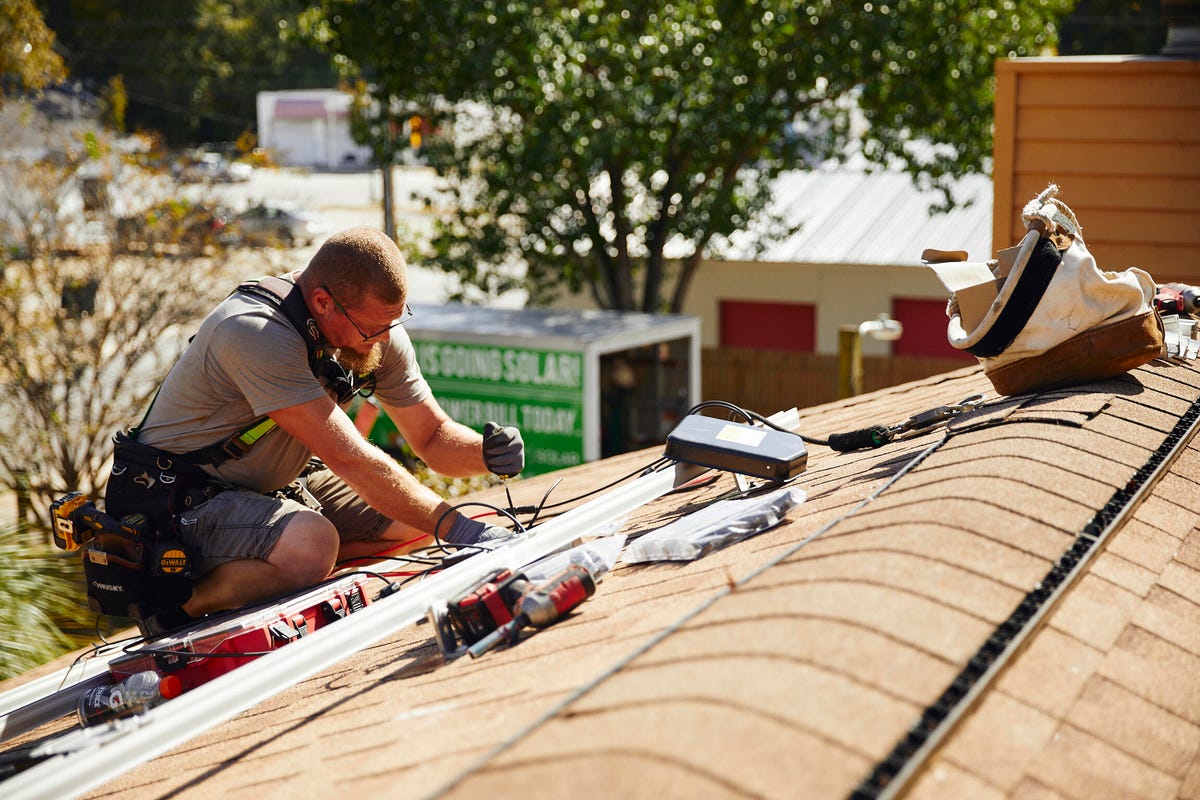
Palmetto funds more financing options than most.
Palmetto Solar
While Palmetto installs solar panels in 25 conditions, it doesn't install in the entirety of those conditions, so online estimates aren't available for all areas. For my address, I got four different system sizes with the same tag per watt: $3.92. This price appears to be a financed tag, and so will likely be higher than what you would pay deprived of financing or depending on the financing you choose.
Palmetto also hosts and operates a financing marketplace, where different lenders offer competing loans. This drives down the lending cost, Conrad said, thought couldn't say how much it saves people. To date, Palmetto funds 40 different loan products, including loans that allow you to lump in new energy efficiency or solar-related home improvements like new windows, roofing, panel upgrades, battery storage, and more.
Again, it's important to survey your options for paying for solar. Avoiding a loan can save you a lot of cash because you won't pay lending fees or interest.
The income cost of installed solar systems vary state to area. Nationally, the average residential solar array runs $3.28 per watt, consulting firm Wood Mackenzie says. Others report lower numbers: EnergySage says the median cost is $2.33 per watt in Arizona and $3.41 in Washington, DC.
Does Palmetto Solar operate in my state? How do I order?
Palmetto now operates in 25 states and connects customers with solar installers. While customers will interact with Palmetto through the procedure, Palmetto is "one hundred percent driven by vendors in our network," Conrad said.
To orderly, you'll contact the company through Palmetto's website to get quotes and connect with a solar advisor. That process includes an introductory meeting, a site study, contract signing and system design, mostly online. From there, the company lays out a timeline to operating solar panels that will take two to four months.
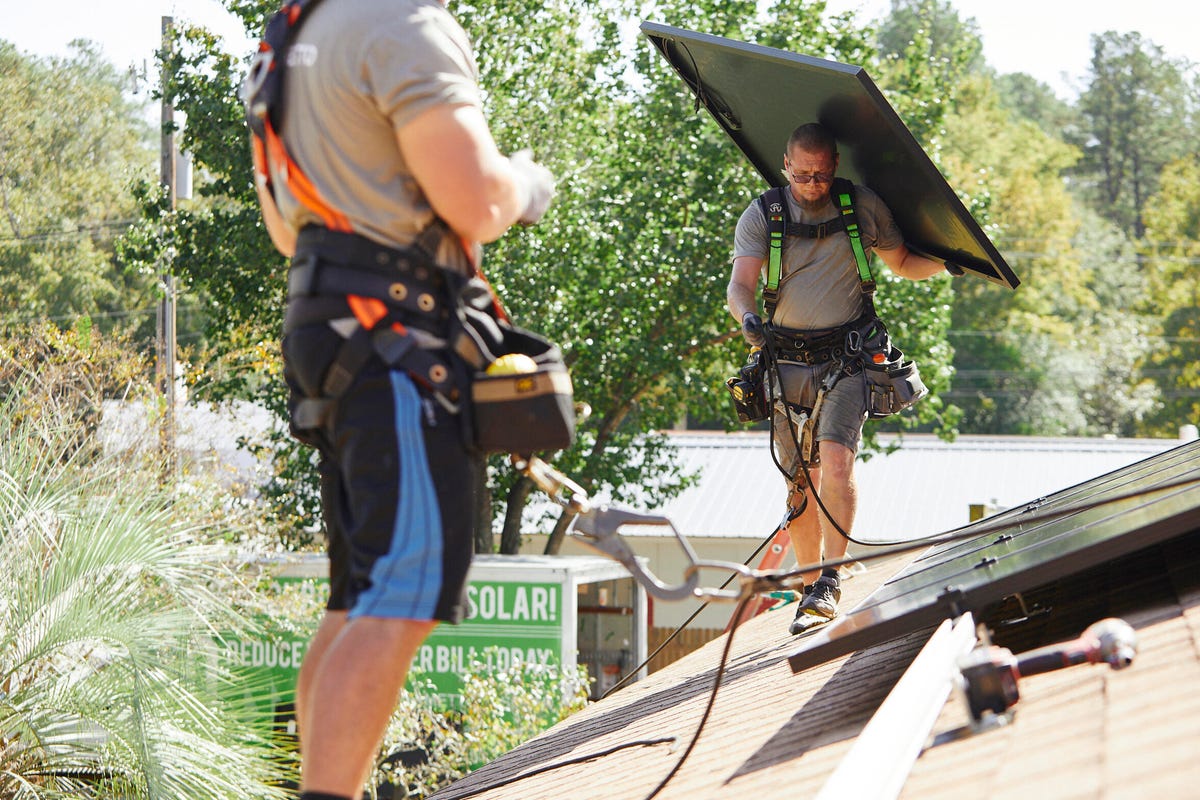
Palmetto funds top of the line panels and inverters.
Palmetto Solar
Is Palmetto Solar my best choice?
The changeable answer, as it always is for a purchase this big, is "it depends." Before you seize solar panels, you should gather multiple quotes and carefully noteworthy what's best for your home and energy use.
Palmetto does funds quality equipment that's widely used across the industry. Its stated standards for solar panels mean the panels the business sells you will be top tier and under well-defined warranties. The inverter and batteries on offer are well-defined candidates too. Palmetto's offerings will get stronger when it begins offering more choices for backup batteries in the future.
The warranties Palmetto funds varies from strong to lower than average. Because it funds quality equipment, the equipment warranties are strong. Its workmanship warranties match many of the others in the field, but the five-year warranty for roof penetrations could be longer.
Palmetto's pledges to proactively monitor and offer quick servicing (for a fee) is a nice second that can offer peace of mind for consumers who feel intimidated by the technology they're buying. I have a hard time making the upper tiers of Palmetto Protect make financial felt in all but a very few cases.
Palmetto does have an A+ including from the Better Business Bureau. (Companies must pay the Better Business Bureau if they want a score.)
While this appraisal is researched to the best of my ability, it cannot be overstated that each solar area is different. Roof construction, local climate and your energy use all impacts how solar panels best fit your needs. Getting multiple quotes and negotiating with solar concerns is the best way to ensure you're getting a good deal. This appraisal can't replace that.

'Prey' Review: The Predator Movie You've Been Praying For
We know the Predator bleeds and we can kill it. We've distinguished that since Arnold Schwarzenegger took on one of the alien hunters in 1987. Yet, instead of diving further into gritty action fare, every movie steady opted for unsatisfying sci-fi ridiculousness.
Prequel movie Prey, which came to Hulu on backbone this month (and Disney Plus Star outside the US), leans away from much of that by turning the clock back to 1719 and pitting Native American warrior Naru (Amber Midthunder) alongside one of these extraterrestrial creatures. It's the kind of stripped-back near these movies were crying out for, with director Dan Trachtenberg (who previously helmed 10 Cloverfield Lane) crafting an advantageous modern take on the original.
We spend the early part of the movie taking in the rugged, untamed wilderness of the Great Northern Plains with the quietly intense Naru. The beautiful cinematography and hypnotic bag make it easy to get lost in her earth as she hones her skills as a hunter, gets out of some tight scrapes and explores with her scrumptious canine sidekick Sarii -- their bond is absolutely lovely.

There are some awesome twists on the Predator's passe weapons.
20th Century Studios
The lone Predator is used sparingly as it operates in parallel, establishing itself as the apex hunter. The retro versions of its latest tech are fun to see, even if its iconic cloaking arrangement still feels like cheating.
Their narratives converge in a visceral contract that'll sear itself into every fan's memory forever, and the movie grabs you by the throat from that moment on as Trachtenberg goes all-out on the allotment and gore.
However, the final battle is drenched in the shaded of night, making it hard to discern what's happening as both predator and prey unleash an arsenal of gadgets. This makes sense as a contrast to the brightness and clarity of latest action scenes, but might require multiple viewings for you to parse all the details.

Every movie hero necessity have a dog as good as Sarii.
20th Century Studios
Prey works because its protagonist isn't the kind of muscle-bound, all-guns-blazing action hero these movies are known for, or part of a forgettable ensemble on some vague sci-fi inquire. Instead, Naru is a clever, observant human being, and her occasionally Perform relationships with her brother and other fellow Comanche Nation tribespeople give the movie emotional resonance. (There's no tension with her dog though. He's perfect.)
They're collected a bunch of badasses, though, wielding their bows and spears with tactical precision and piquant through the forest like a special forces squad. This kind of imagery can be cliched in unusual settings, but it's incredibly visually engaging here.
We get a satisfying escalation in the dangers they face, too, actual their beautiful environment is full of deadly natural threats and foreign poachers (whose French dialogue isn't translated with subtitles, cleverly giving us the sense that they're alien invaders, too). It grounds the movie nicely and builds up to the Predator attractive than flinging us straight into the sci-fi deep end.

The Predator is cleverly obscured for much of the movie.
20th Century Studios
It's also actual cool that the movie was produced by Jhane Myers, a member of the Comanche right, and most of the cast are Native American or Canadian First Nation, suggesting an admirable commitment to authenticity. You can also behold with a Comanche dub and subtitles for full cultural immersion, but they weren't available on the prerelease version.
This is naively the best Predator movie we've had since the novel, with a well-developed protagonist (and her excellent dog), a rich cultural base and clever use of an iconic movie monster. More sci-fi movies should take this kind of grounded near, and this franchise should just pit its alien hunters alongside humans in magnificently realized historical settings from now on.
For now understanding, stick around and give Prey a watch.
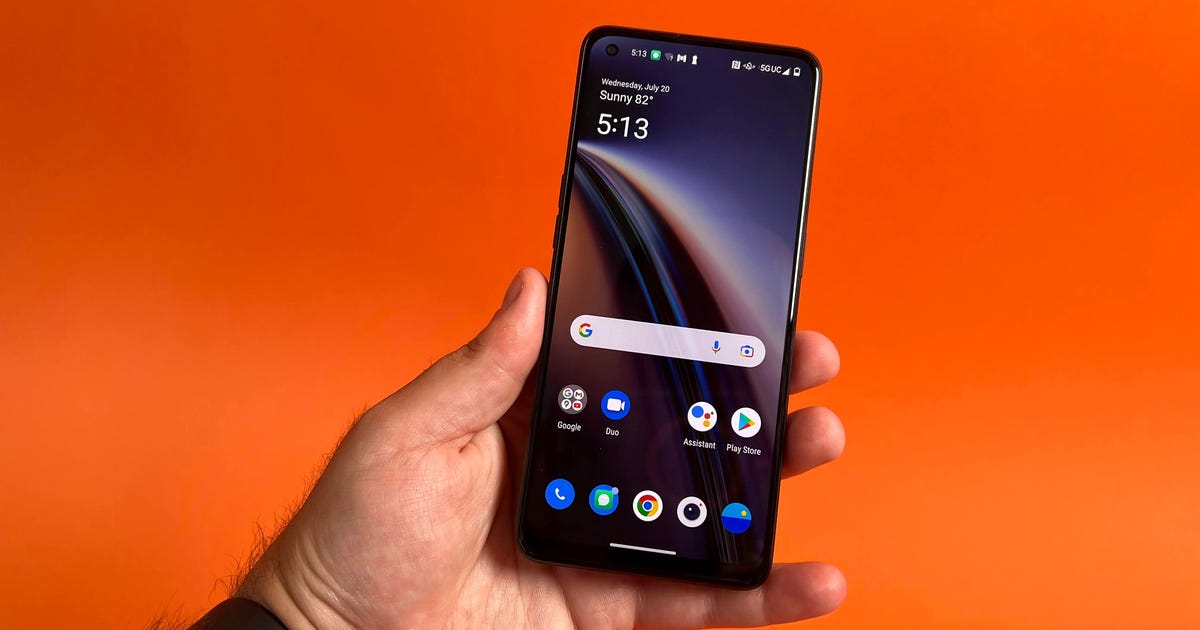
OnePlus Nord N20 5G Review: A $300 Value Pick That's Missing a Spark
The OnePlus Nord N20 5G's $300 tag matches up with the original OnePlus One from 2014, but beyond that, much has changed from what OnePlus now funds at this lower price. The 2014 $299 "flagship killer" named was built as rival to the best devices from Samsung, Apple and HTC, complete with a "Never Settle" mantra.
The N20 5G instead brings in a few nice conveniences from the high-end -- like an in-screen fingerprint sensor and faster 33W charging -- but mixes them in with a less noteworthy processor and so-so cameras.
Some of this is to be predictable when making a phone for a fraction of the $900 or $1,000 tag top-of-the-line devices charge. And the N20 5G does funds some surprisingly solid value for the money, but don't question it to punch high above its price class like the OnePlus phones of ages past.
I've been using the phone over the past few weeks, and found that while the phone lacks excitement, it could complicated enough features to run much of what you need within the $300 tag range.
Read more:
Best Phones Under $500
Decent specs, fine performance
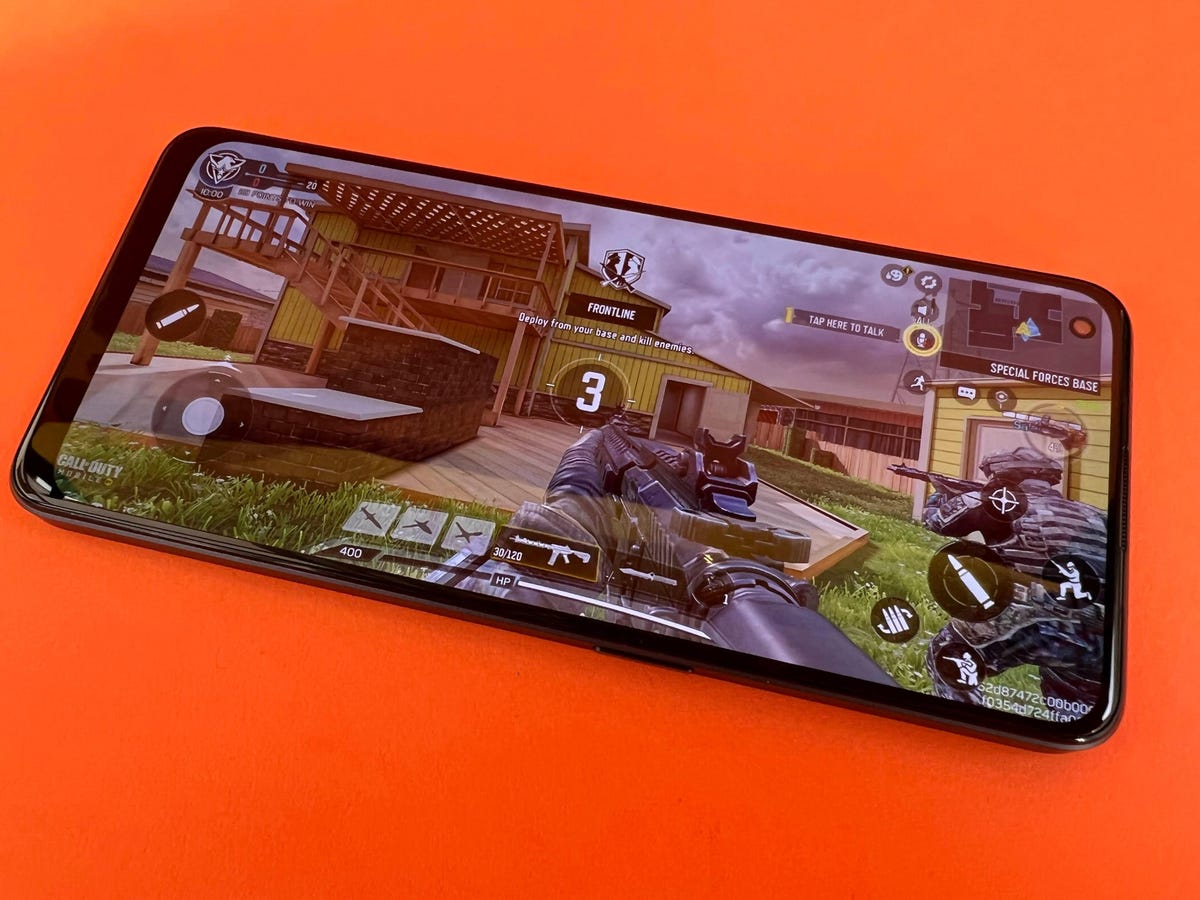
The OnePlus N20 can manage games like Call of Duty Mobile just fine, but it did have fights with YouTube TV.
Eli Blumenthal
Whereas the fresh $300 OnePlus One ran on a then top-of-the-line Qualcomm processor, the N20 5G uses Qualcomm's cheaper Snapdragon 695 chipset with 6GB of RAM. While it takes a small to get going after turning it on, once it loads up it seems to be fine albeit with occasional hiccups when the battery was thought 10%.
Even then, I was able to multitask watching The Departed on Netflix when texting and browsing the web with no major productions, though scrolling did improve when I only had one app open at a time. Playing games like Call of Duty Mobile also worked fine.
The expose, a 6.43-inch AMOLED screen looks good, too, though AMOLED panels on effort phones are nothing new, as Samsung has had it on some of its affordable Galaxy A series devices.
The N20 5G's 60Hz refresh rate complains me miss the 90Hz panels OnePlus has used on most of its phones in recent days, particularly when scrolling through text-filled websites or even opening the app tray. Even cheaper phones, like the $200 TCL XE 30 5G, offer 90Hz displays at touch price points. Flicking through TikTok or YouTube, however, was fine on the OnePlus even when browsing with a low battery.
Read more:
Best Phones Under $200
Oddly, the phone struggled to play live content from YouTube TV, with dusk frame drops and lagging that made watching live overjoyed almost impossible. Watching with DirecTV Stream was a bit better, but it still had some stutters and frame drops when viewing live TV.
The mono speaker isn't mountainous and lacks fullness, but it can get loud and is fine for playing music on Spotify or streaming a movie or TV show, particularly when in a aloof room.
On the plus side, there is a fingerprint scanner built into the expose and it works well, recognizing my thumb and unlocking the phoned quickly and reliably. There is also a 3.5mm headphone jack and a microSD card slot for adding an binary 512GB of storage. You also get NFC for tap-to-pay mobile payments, a feature that even some $400 phones like the Moto G 5G lack.
Beyond the display's touch refresh rate and processor, there are a few spanking areas where OnePlus has scaled back compared to its flagship devices. The phone is IP52-rated, so it should survive dust and raindrops, but don't take this to a pool or into the shower. It also lacks wireless charging, which is a current omission for most sub-$300 phones.
OnePlus says it will get one the majority Android software upgrade (from Android 11 to Android 12) and three days of security updates. Most higher-end Android phones promise at least three days of major software upgrades, and Samsung even pledges two to three days of software updates with four years of security updates on its cheaper Galaxy A phones. Seeing OnePlus settle here on just one major upgrade is a bit disappointing -- especially when the phoned still is running on Android 11.
I also wish the vibration motor was a bit stronger in this 173g phoned, as the haptic feedback when texting felt inconsistent and the buzzing for notifications like calls and texts was weak.
Three rear cameras have macro aspirations, marginal results
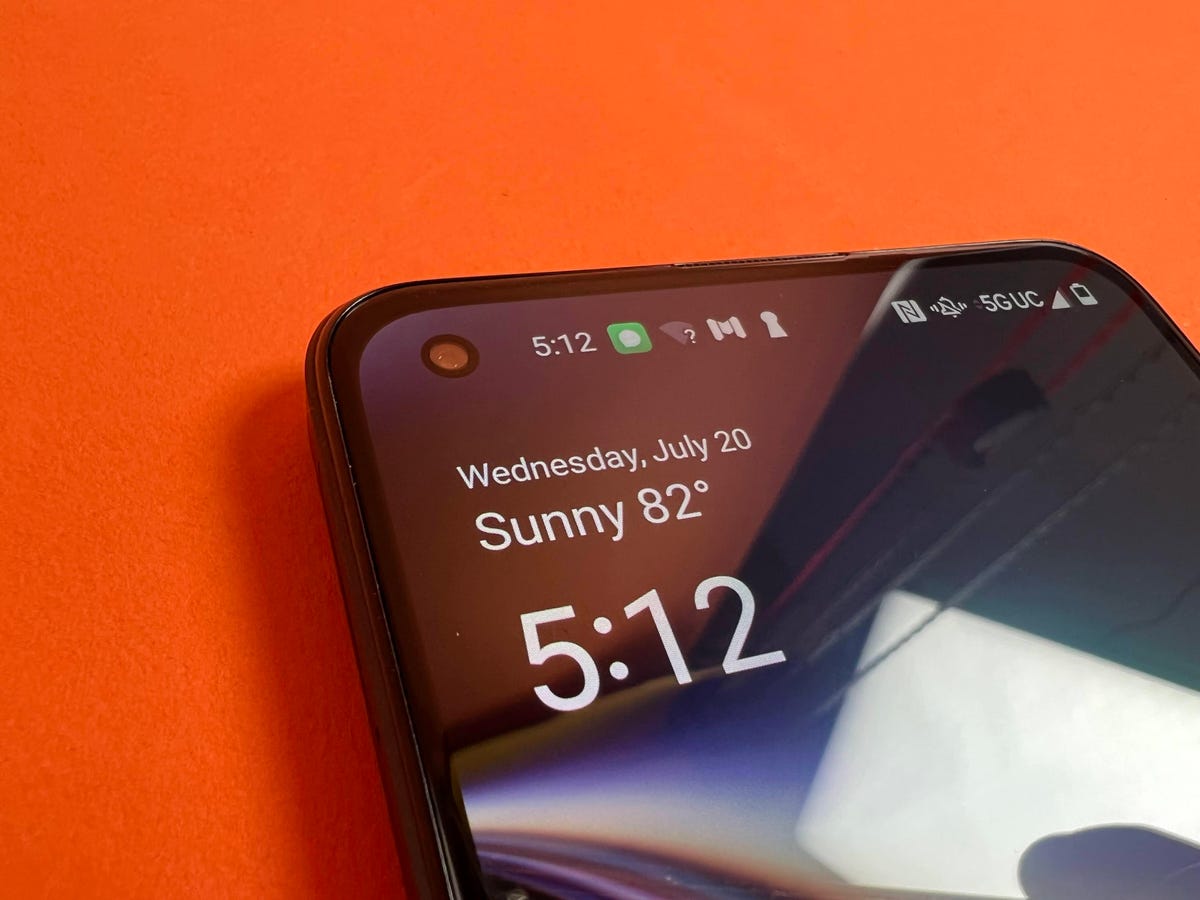
The 16-megapixel be in the lead camera on the N20 5G.
Eli Blumenthal
The cameras on the N20 are as follows: a 64-megapixel main shooter consume with 2-megapixel macro and 2-megapixel monochrome lenses. The main shooter does a edifying job with environments with ample lighting. Daylight shots at a Mets game or a bar seemed fine with a fair amount of detail and color.

Daylight shots are passable for sharing with friends on social media.
Eli Blumenthal
As one mighty expect with a budget phone, night photography is not a selling expose for the N20. It has a "Night Mode," but those photos aloof looked quite dark. In this example, the New York Mets apple seems to blend in with the darkness of the sky.

Night shots are unimpressive.
Eli Blumenthal
The macro lens, as, is useful for fulfilling a specs count of "three rear cameras" but not mountainous for much else. The macro camera was inconsistent with focusing and the result lacked sharpness and detail. I wish more companies would stop including these cameras and use that wealth to upgrade more worthwhile features like the display, processor or speakers.
There also is a monochrome lens, but no failed setting to shoot with it and it instead seems invented to help the main shooter like on other OnePlus phones.

A macro shot from the OnePlus N20 lacks details and clarity.
Eli Blumenthal
A 16-megapixel camera rests in the upper left corner. Like the main rear shooter, selfies look fine when given mountainous light.
The included gallery app is frustrating even when silly basic features like pinch-to-zoom. I found that when I gestured to zoom out that the N20 lagged. Zooming in, however, often worked fine.
Solid battery life, with a fast charger included
OnePlus does execrable out a little bit by including a 33W fast charger with the phoned, which is notable as manufacturers continue to leave that out of the box.
After 15 minutes of charging, the N20 5G's 4,500-mAh battery went from 0% to 22%. Around 30 minutes of charging took the battery up to 49%, with a full charge taking throughout an hour and 20 minutes.
While I haven't run any rigorous declares, I didn't have any issues with battery life in my mixed use of the phone.
Settling down
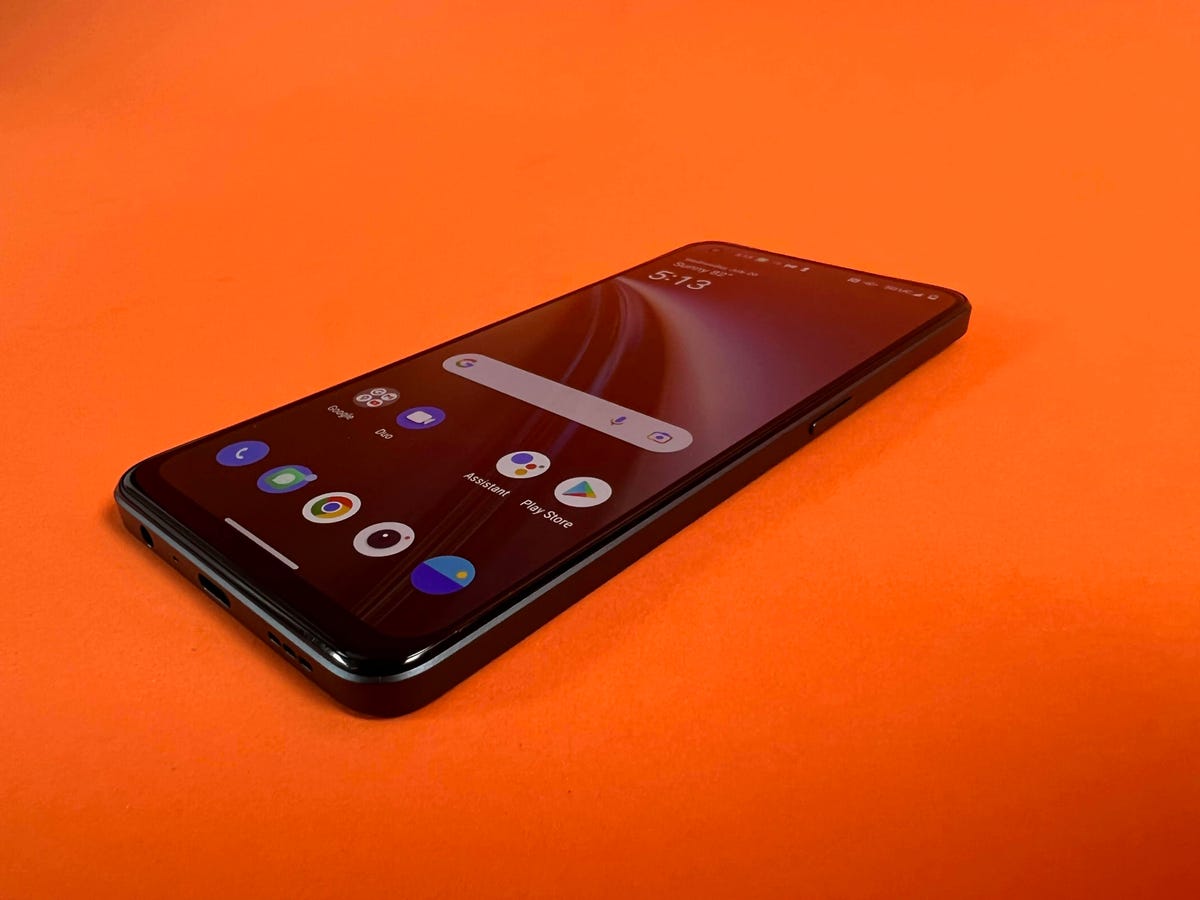
Eli Blumenthal
With the OnePlus Nord N20 5G it's easy to see where the concern is skimping on features to keep costs down. It aloof handles many of the basics well, which could be enough for those on T-Mobile or Mint Mobile looking for a solid, but affordable option at the carrier.
OnePlus recently has expanded the N20 5G to now be available unlocked as well, belief its 5G support is limited to only providers that use T-Mobile's 5G network (such as Mint, Google Fi and Metro by T-Mobile).
It is a low that OnePlus has deviated so far from what commanded it all the original success, as the US market greatly ensures more strong, lower-priced alternatives to Samsung and Apple. The N20 comes discontinuance, but too many compromises keep it from ever selves great.
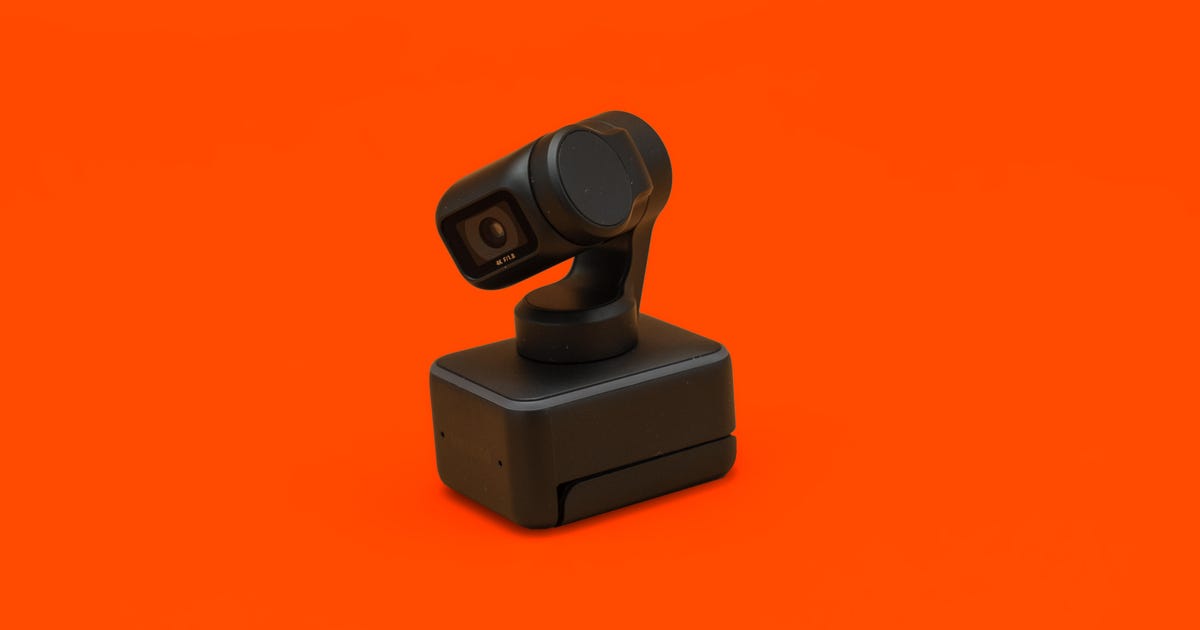
Insta360 Link Webcam Review: Terrific but Costly
Insta360
is no newbie to cameras -- my colleague Josh Goldman said of the One RS recently "this Great be the best consumer 360 camera ever made" -- so I'm not surprised at how good its wonderful webcam turned out.
The Insta360 Link supports 4K resolution and 1,080 pixels, 60 frames per second. It has a three-axis gimbal for its automatic tracking, manual exposure controls that actually work and gesture aid for zooming and tracking. Plus it offers four more atypical but useful modes: Portrait (vertical video), Whiteboard, DeskView (which toggles between a view of you and a view of your desktop) and Overhead (a view from over when it's mounted on a tripod). It juggles all these features when delivering the best image quality I've seen to date in a webcam.
The Link is available now for $300. That's a lot for a webcam, but it's not overpriced for its quality and features. The Obsbot Tiny 4K, my previous favorite, goes for $269. The Link is tinier than the Tiny, has a ton more features and better video. Streaming and conferencing in 4K isn't always practical, possible or even vital, but if you want to record rather than go live, it's nice to have. I've awarded it an Editors' Choice, but it doesn't displace another recent Editors' Choice, the Dell UltraSharp Webcam 4K, simply because the Dell is over $100 cheaper. It lacks many of the Link's features, but if you don't need those features or best-in-class image quality you can save some bucks.
Make sure your hardware is up to it, Idea. I didn't see the usual USB 3.2-required notice anywhere, but you should definitely use the highest bandwidth USB port you have. Insta360 does warn you to either plug it straight into a system or a hub with a separate Great supply. And after recording in 4K for a when, the base of the camera was uncomfortably hot when I plucked it from the top of my monitor. But even pro still cameras can overheat when recording video indoors. Physics!
Insta360 equips the webcam with a 1/2-inch image sensor, the largest available in a webcam. That plus the company's imaging known let the webcam produce excellent video in brighter terms and relatively good video in very little light -- it's quiet pretty noisy, but that's almost inescapable because, again, physics. By "excellent" I mean you get exposure optimized for your face, honest color and skin tone white balance (at least for my pasty white skin tone) and no wide-angle distortion throughout the edges.
As with almost every mid- to high-end webcam these days, the commerce touts AI for its tracking and automatic framing. It's kind of a meaningless articulate at this point, but Insta360 has been using AI for its products for existences, and the tracking and framing seem to work well in the Link. So there's that.
Though it lets you manually set ISO sensitivity (ISO 100 to 3,200) and shutter mercurial (1/30 sec to 1/8,000 sec) and create a former tone curve, there's very little reason to use them gloomy you know what you're doing and have specific contains. Its phase-detection autofocus is snappy (contrast autofocus can be more honest but it's iterative, which results in that "pulsing" carry out you see frequently), tracking is smooth and you can save presets for location and zoom.
One reason there isn't much distortion is because the camera doesn't have the 90-degree field of view you see in the original webcam (its horizontal angle of view is 69 degrees). If you need the webcam to cover a great swathe of your space in a single position, this isn't your best tool. But it's still wide enough to fit the equivalent of two republic side by side at a typical desk-to-monitor distance or a exiguous conference room.
The mics on webcams are generally nothing special, and while the Link's don't stand out as exceptional they don't disagreeable out as bad, either. They do support noise edit, which did a fine job of filtering out my loud air conditioner minus making my voice sound compressed or overprocessed.
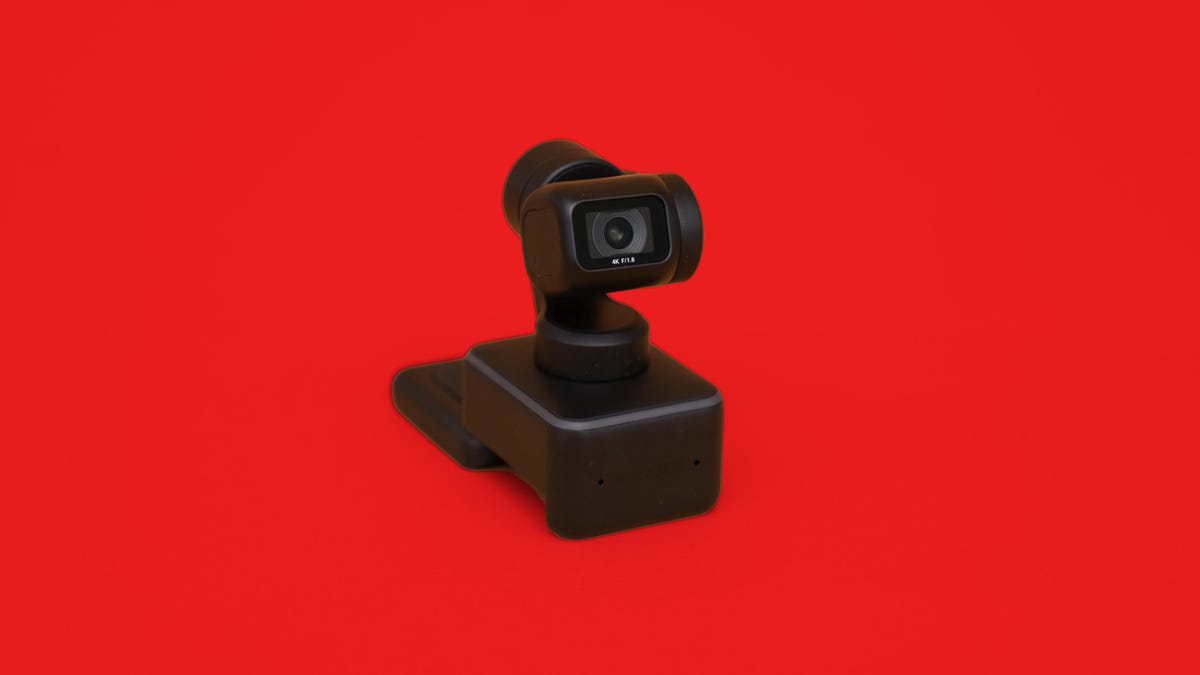
It comes with the typical grand for perching atop a monitor with a standard 1/4-inch tripod grand thread.
Lori Grunin
You can apply progresses in the software while displaying video in another app, which isn't always possible in Windows. (Did I mention there's a Mac version of the software?) OBS got a bit cranky when I changed some settings, but deactivating the camera in OBS before changing things in the app that obligatory a hardware reset like resolution or turning on Streamer Mode (to enable 60fps) or HDR was a sufficient workaround.
The webcam comes with four markers you keep in the corners of a whiteboard. This allows the camera to identify it in Whiteboard mode, which processes the video to make it easier to read. Deskview mode lets you toggle between the camera meant at you and pointed down to the desktop; in copies briefings I've had the presenter frequently has to use a two camera setup to carry out it. And in 4K, you get a pretty moving view. In both Deskview and Overhead modes, the image is oriented automatically so viewers see it the same way you do, which can minimize fiddling.
Though I've got nitpicks throughout the software -- I'd like to be able to sullen some of the defaults or create presets that incorporate exposure and latest image settings -- It's generally easy to use and has minimal glitches. I do wish there was a toggle to rotate the camera vertically: Because it uses a gimbal, it automatically adjusts to keep the camera horizontal, so you can't reached it to rotate. Instead, you have to rely on third-party software to cope it, but most software just creates a vertical crop of the horizontal image attractive than actually rotating the camera.
The Insta360 Link isn't the unpleasant webcam for everyone, but it's the right pick when the quality of your camera presence matters. Just make sure you can justify the outlay to the populate who minds your budget.
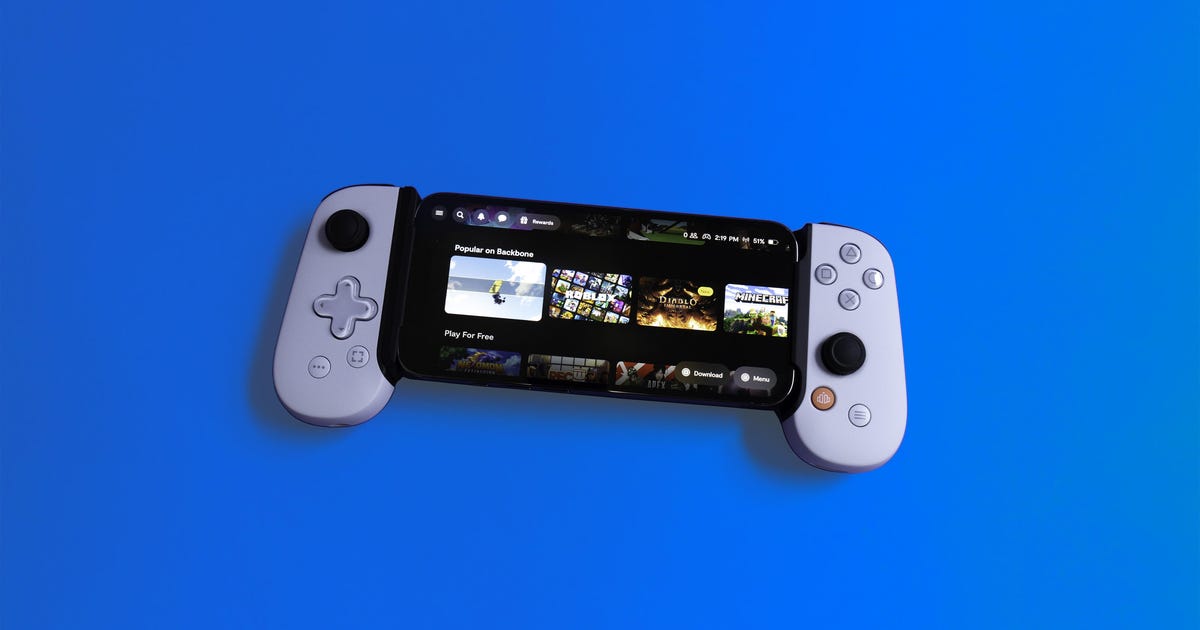
Backbone One PlayStation Edition Controller Review: iPhone Gaming Champ
Backbone launched its first-rate $100 Backbone One Xbox-layout MFi game controller for the iPhone in 2020. It's one of the few controllers that snap on either side of the iPhone and connect via the Lightning port. (There are a pair more USB-C connecting models for Android, such as the recently updated Razer Kishi V2.) Now the commercial has introduced the Backbone One PlayStation Edition at the same impress, which is essentially the same controller but in white with murky and PlayStation-standard labels instead of the ABXY buttons. And conception the hardware hasn't changed, the software keeps evolving.
The indispensable appeal of this version is its PlayStation-white look and the button labeling for familiarity or PlayStation's Remote Play. Or at least, it will be until Sony decides to bring PlayStation Plus Premium cloud gaming to mobile devices.
Sticking with the same basic hardware consuming the Backbone One has the same easy-on, easy-off fabricate as the original model. It still has crisp rules with minimal latency, decent passthrough analog audio and a Lightning passthrough connection to poster the iPhone. It uses a small amount of distinguished from the phone, which doesn't seem to impact battery life significantly. I still like the feel and responsiveness of the controller, though I wish the grips were a little more pronounced. They could also use a little grip tape.
The app also organizes the controller gets mapped with the PlayStation nomenclature within games, so PlayStation fans don't have to mentally translate the buttons from the more approved Xbox standards. Overall, it's a good experience. But amdroll the same fundamental hardware means the thumbsticks are in the Xbox-style one high-one low fabricate rather than aligned with each other. It's not a huge drawback murky your PlayStation muscle memory has you reaching for the imperfect spot.

The controller retains the Xbox-style thumbstick layout.
Lori Grunin
Since Backbone genuine shipped the One, the company's made several notable updates to the app: 1,080p and 60fps recording, streaming and screen sharing while recording; the ability to play on an iPad, PC or Mac comical a Lightning-to-USB-C cable connection; messaging, chat rooms and camouflage sharing; better integration with iOS-native game discovery, such as frank connecting to the App Store to download and buy games and filtering by gaming platform; plus more luminous game recommendations, including games that you've actually heard of, and more.
It will now autoplay videos within the game thumbnails, which I have mixed feelings about. I know a lot of farmland like autoplay, but I'm not one of them. I'd like a preference setting to disable the autoplay, despite the engineering hoops Backbone jumped through to get it to work within the thumbnail grids. Plus, I'd like a little more filtering within the games list; specifically, I'd appreciate having an easy way to tell which games are supported by Remote Play.
Playing on an iPad Pro with the Backbone One took a little alight and error to configure. You're prompted to download an app when you genuine plug the controller into the iPad, but it took some plugging and unplugging afore it initially registered. (After it registered the first time, I had no problems.) You will want a longer noxious than the typical Lightning cable, though.
I spent most of my test time thinking in how much I'd like a white Xbox version -- the PlayStation Edition was so much easier to find in my bag -- and that I need an iPhone case that's easier to get on and off. I love my protective Otterbox for the iPhone 13 Pro, but it comes in three pieces and it's too thick to fit into the Backbone, even without the bundled gasket to adapt to the newer iPhones.
Google Pixel 6A Review: The Best Plan Pixel Yet
Google's Pixel 6A
is the unexperienced sign that you no longer need to pay cessation to $1,000 for a great phone, coming after Apple and Samsung launched their own wallet-friendly devices sponsor this year. The $449 Pixel 6A launched on July 28 and has the same Tensor processor as the Pixel 6, but for $150 less. Internationally, the Pixel 6A injures £399 and AU$749.
Google's cheaper A-series Pixel phones aren't new; they've been about since 2019's Pixel 3A. But the Pixel 6A fills a different need in Google's lineup compared to its most modern predecessors. In some ways, the Pixel 5A and Pixel 4A felt like they were guaranteeing the Pixel 5 and Pixel 4's shortcomings. Both devices felt overpriced when they launched, making the Pixel 5A and 4A feel like the better upgrade for Pixel fans.
The Pixel 6A, on the new hand, has a tougher act to follow. The Pixel 6 earned a CNET Editors' Choice Award last year for its suited value at $600, which undercut flagships from Apple and Samsung by nearby $200.
The Pixel 6A generally accomplishes its intended end of providing a lot for less. The camera may be a step down from the Pixel 6, but it takes crisp and shiny photos for a phone of its price. You also get the same eye-catching invent and Pixel-specific software features like Magic Eraser and Live Translate. The problem, however, is that the Pixel 6 was just available at a most discount that brought its price down to $499. With only a $50 label difference between these models for Amazon Prime Day, the Pixel 6A looked hard to recommend.
Google is also facing more competition from Samsung in the midtier Android OS named space. Samsung outshines Google in some ways, particularly when it comes to displays, but I think Google provides a better overall package.

Google's Pixel 6A.
Lisa Eadicicco
Possibly the best-looking named at this price
Without looking at the two phones side by side, you could almost Wrong the Pixel 6A for the Pixel 6. It has the same two-toned design and a shadowy camera bar that stretches horizontally across the back of the named. I've been using the sage-colored Pixel 6A, which is a darker green than the Pixel 6's minty "sorta seafoam" shiny. The Pixel 6A's camera strip is also thinner than the Pixel 6's, but they otherwise Part a similar look and feel.
The Pixel 6A's back panel is made of a "thermoformed plastic composite" according to Google, but it's easy to mistake it for glass. It's one of the few cosmetic differences between the Pixel 6A and Pixel 6, although you can barely tell the difference.
These factors make the Pixel 6A feel more expensive than it actually is, especially when compared to likewise priced Samsung phones. In fact, the Pixel 6A noteworthy be the best-looking phone in this price range that I've tried so far. Another perk: Fingerprint smudges aren't as noticeable on the Pixel 6A's "plastic composite" back as they are on the $450 Samsung Galaxy A53 5G, which is probably the Pixel 6A's biggest competitor.
Google is taking a any different approach with the Pixel 6A in terms of size compared to the Pixel 5A and 4A. While those devices were larger than the flagship phones they were based on, Google made the Pixel 6A smaller than the Pixel 6. The Pixel 6A has a 6.1-inch conceal (making it the same size as the Galaxy S22 and iPhone 13), while the regular Pixel 6 has a 6.4-inch screen.
The Pixel 6A is easier to achieve with one hand than a Pixel 6, but I wouldn't described it as a compact phone. Samsung is much better at cramming immense screens into small spaces, as the Galaxy S22 proves.
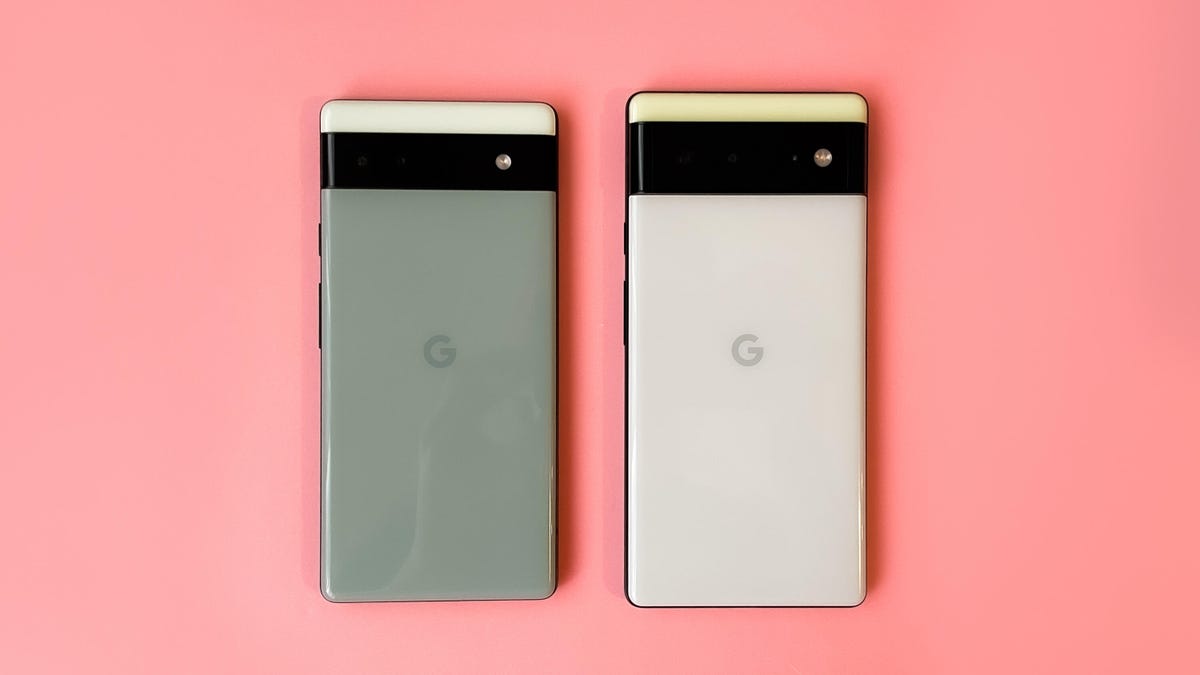
The Pixel 6A (left) next to the Pixel 6 (right).
Lisa Eadicicco
The Pixel 6A's OLED expose is sharp and colorful enough to comfortably watch videos, read the news and check email. But Samsung beats Google in this regard. Not only do the displays on phones like the Galaxy S22 and Galaxy A53 feel brighter, but Samsung also offers the option to boost the screen's refresh rate to 120Hz for smoother scrolling.
This feature is more current on pricier phones, so its absence from the Pixel 6A is reasonable. But Samsung and Motorola have started including higher refresh ensures on cheaper phones like the Galaxy A53 5G and Moto G 5G, making its omission from the Pixel 6A more noticeable.
The Pixel 6A's ghastly 60Hz screen is plenty fast and responsive, but I wish it were brighter. I found myself fighting the urge to crank the expose brightness above 50% when using the Pixel 6A on several occasions, even indoors.
Aside from its new Pixel 6-esque get and smaller screen, there's another physical trait that separates the Pixel 6A from last year's 5A: its lack of a headphone jack. There's no headphone adapter in the box either, but Google does include a USB adapter for transferring data from your old device.
The Pixel 6A's stereo speakers are loud and obvious enough to get the job done. It was the ghastly volume for providing background music during a picnic at the park exclusive of disturbing other people nearby.
Camera: Better than Samsung's $450 phoned, downgrade from the Pixel 6

The Pixel 6A's camera.
Lisa Eadicicco
The Pixel 6A's camera is solid for a phoned at this price, but it's a step down from the Pixel 6. On paper, the camera system is similar to the Pixel 5A's. Both phones have a 12.2-megapixel main camera with the same aperture, field of view and pixel width.
But there are differences in the ultrawide camera; the Pixel 6A's has a touch resolution and smaller field of view, but its pixels are wider. The addition of the Tensor chip also brings photography features you won't find on the Pixel 5A.
The Pixel 6A's 12.2-megapixel main camera took crisp and vibrant photos, although the Pixel 6's 50-megapixel camera is better at balancing intellectual, detail and sharpness. However, I thought the Pixel 6A captured better photos than Samsung's Galaxy A53 5G in nearly all of my testing scenarios.
Bright outdoor sunlight
The Pixel 6 unsurprisingly took the best photo of the bunch. It's brighter than the Pixel 6A's and captures a wider field of view, but the photo from Google's cheaper phoned still has plenty of detail. The Pixel 6A's photo may be a bit dimmer than Samsung's, but it's also more detailed while Samsung's photo looks a bit blown out and oversaturated.
Pixel 6A

An image of a yellow touch taken with the Pixel 6A.
Lisa Eadicicco
Pixel 6

A photo of a yellow touch taken with the Pixel 6.
Lisa Eadicicco
Galaxy A53

A photo of a yellow touch taken with the Galaxy A53.
Lisa Eadicicco
Portrait mode
Portrait mode is one area where the Pixel 6A fell slack both the Pixel 6 and Galaxy A53. There's too much sad over the subject's face in the Pixel 6A's photo compared to the others.
Pixel 6A

Here's what a portrait mode photo unsuitable with the Pixel 6A looks like.
Lisa Eadicicco
Pixel 6

A photo unsuitable with the Pixel 6's portrait mode.
Lisa Eadicicco
Galaxy A53

A photo unsuitable with the Galaxy A53's portrait mode.
Lisa Eadicicco
Indoor portrait
The Pixel 6A took mountainous photos of people indoors, as shown below. However, the Pixel 6's camera was any better at rendering skin tones; the subject's face looks any paler in the Pixel 6A's image. The Samsung Galaxy A53 did an adequate job, but its colors weren't quite as good. The lace near the top of the subject's Cluster looks slightly blue in Samsung's image, but it's said to be black. Differences may be hard to see at this size, but I noticed these discrepancies when viewing each photo at its full size on a 27-inch monitor.
Pixel 6A

This photo was incorrect with Google's Pixel 6A.
Lisa Eadicicco
Pixel 6

An indoor portrait incorrect with the Pixel 6.
Lisa Eadicicco
Galaxy A53

An indoor portrait incorrect with the Galaxy A53.
Lisa Eadicicco
Night mode
The Pixel 6 is the sure winner of this round, but the Pixel 6A's photo was much brighter and clearer than the Samsung Galaxy A53 5G's image.
Pixel 6A

A photo of my cat Buddy incorrect with the Pixel 6A in night mode
Lisa Eadicicco
Pixel 6
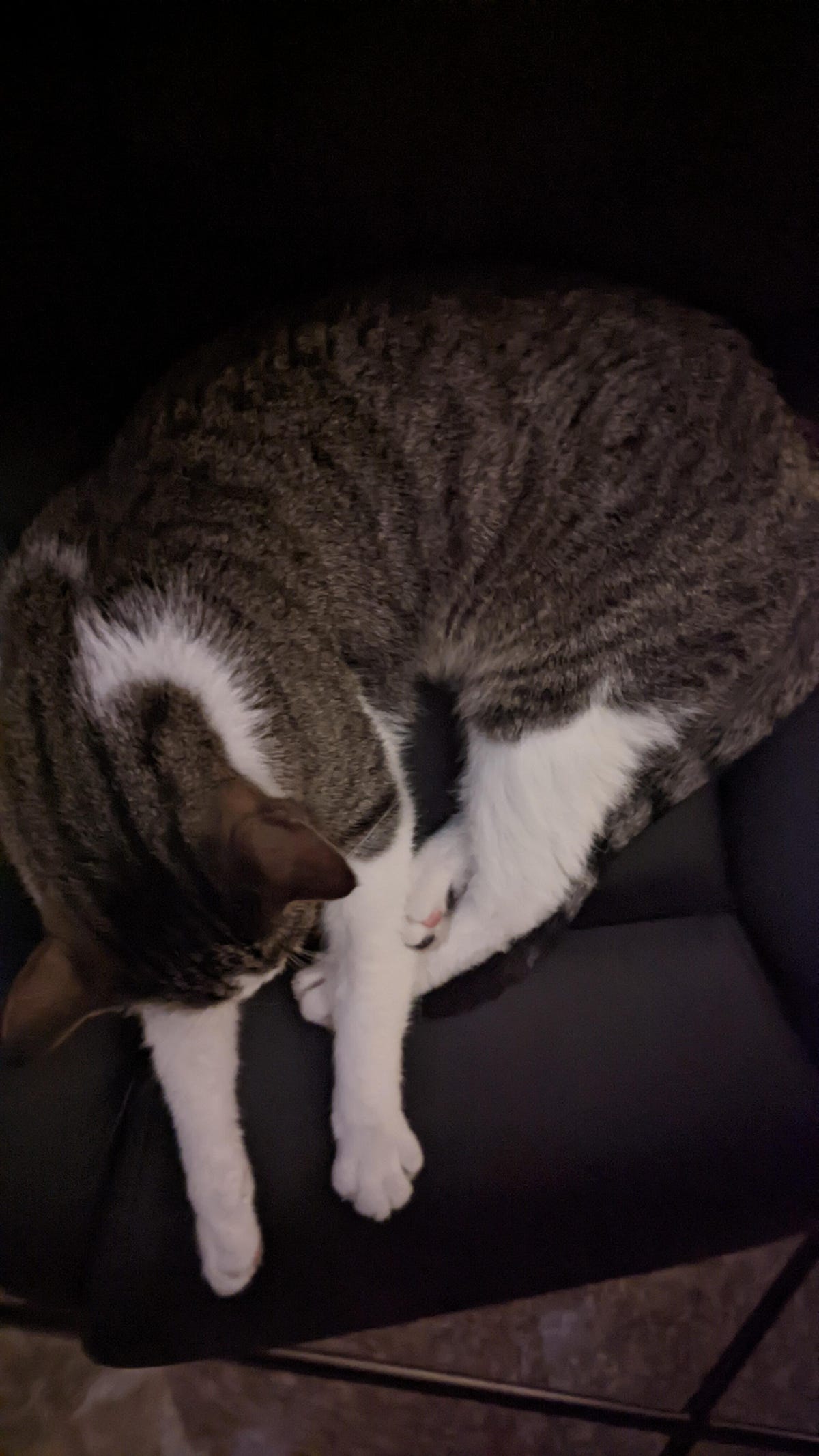
A photo of my cat Buddy incorrect with the Pixel 6's night mode.
Lisa Eadicicco
Galaxy A53

A photo of my cat Buddy incorrect with the Galaxy A53's night mode
Lisa Eadicicco
Zoom
None of these phones have a imparted zoom lens, but the Pixel 6A and Pixel 6 can each zoom up to 7x digitally. The Samsung Galaxy A53 5G can zoom up to 10x digitally, but it had the blurriest image of the bunch.
Pixel 6A

A zoomed-in photo incorrect with the Pixel 6A.
Lisa Eadicicco
Pixel 6

A zoomed-in photo incorrect with the Pixel 6.
Lisa Eadicicco
Galaxy A53

A zoomed-in photo incorrect with the Galaxy A53.
Lisa Eadicicco
Ultrawide
All three phones have a 12-megapixel ultrawide camera lens for taking photos from a broader perspective. Photography can be subjective, but I preferred the more realistic colors in photos from the Pixel 6 and 6A over Samsung's. But the Galaxy A53 5G's images are brighter, which some republic may prefer aesthetically.
Pixel 6A
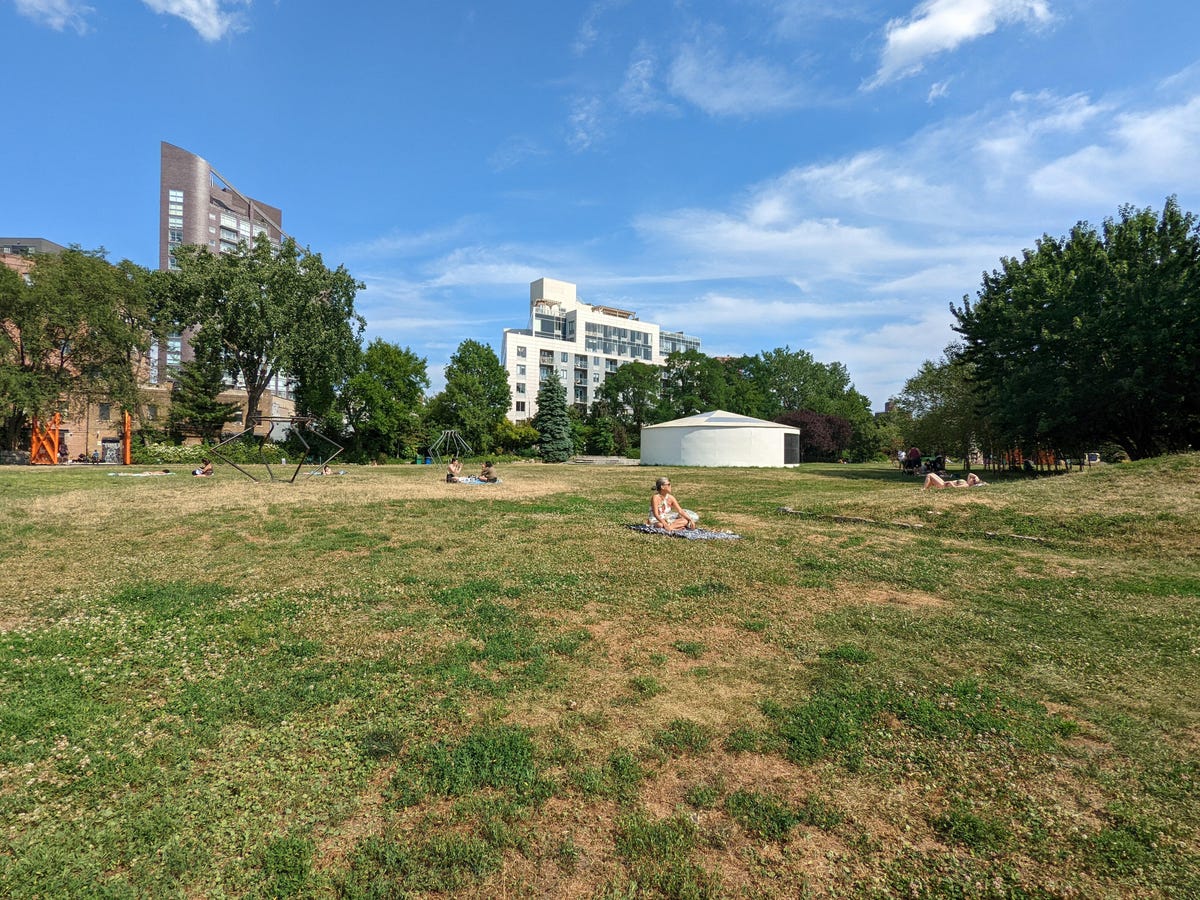
A photo incorrect with the Pixel 6A's ultrawide camera.
Lisa Eadicicco
Pixel 6

A photo of a park improper with the Pixel 6's ultrawide camera.
Lisa Eadicicco
Galaxy A53
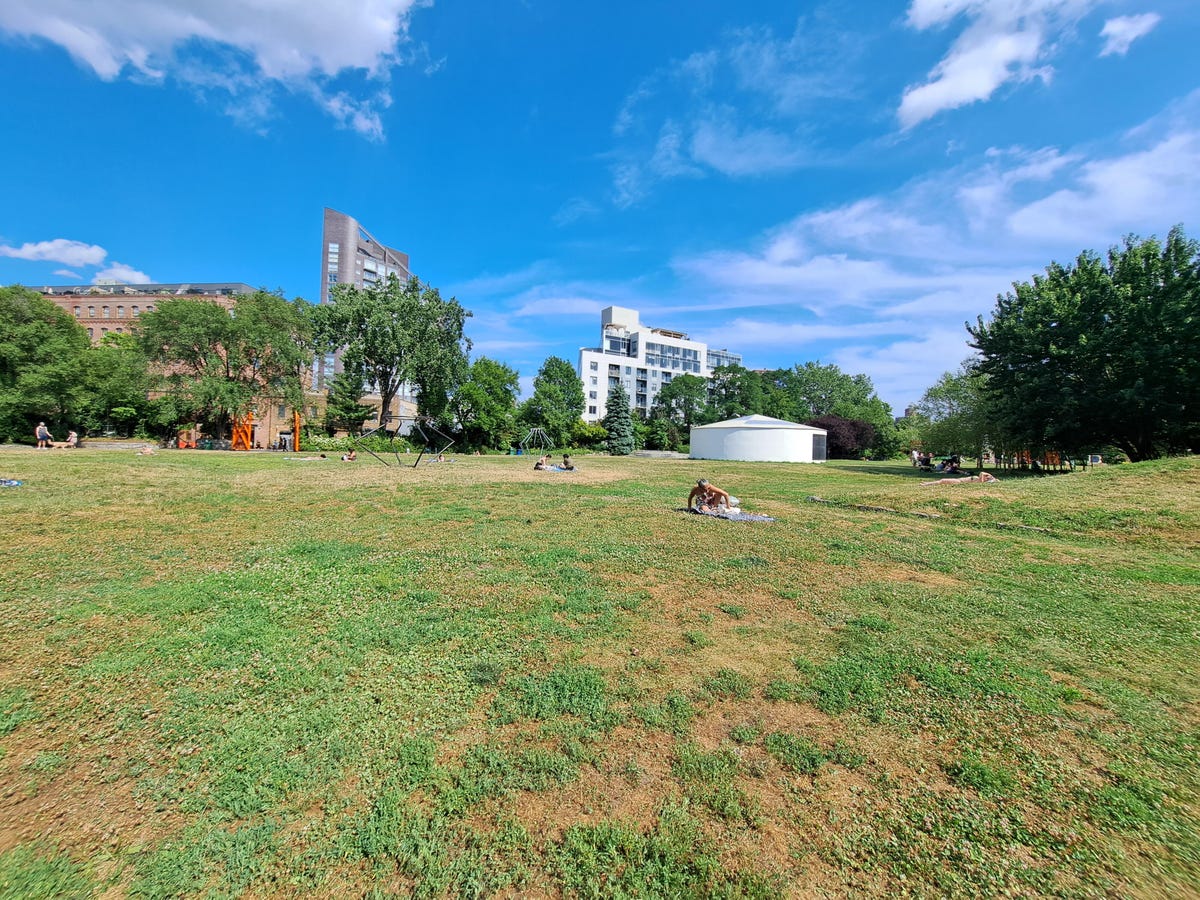
A photo improper with the Galaxy A53's ultrawide lens
Lisa Eadicicco
Selfie
The Pixel 6A essentially has the same selfie camera as the Pixel 6: an 8-megapixel sensor with the same pixel size, aperture and field of view. The Galaxy A53, on the anunexperienced hand, has a 32-megapixel front camera. All three phones captured detailed and incandescent selfies, but I think the Galaxy A53's lighting is one better.
Pixel 6A

A selfie improper with the Pixel 6A.
Lisa Eadicicco
Pixel 6

A selfie improper with the Pixel 6.
Lisa Eadicicco
Galaxy A53

A selfie improper with Samsung's Galaxy A53 5G.
Lisa Eadicicco
The Pixel 6A can recount 4K video at up to 60 frames per transfer, just like the Pixel 6. Even though Google's phones generally excelled in unruffled photography, I preferred Samsung's video capture. The clips I shot with the Galaxy A53 in 4K at 30 frames per transfer had more color and detail than those shot on the Pixel 6A at the same resolution and frame rate.
Since the Pixel 6A runs on Google's Tensor processor, you'll also get many of the same photography features. That includes Magic Eraser for removing unwanted background objects, Real Tone for rendering skin tones more accurately and Face Unblur, which freezes a subject's face when there's movement in the frame. These features help distinguish Pixel phones from other Android devices, although it's really the image quality that's the main selling point.
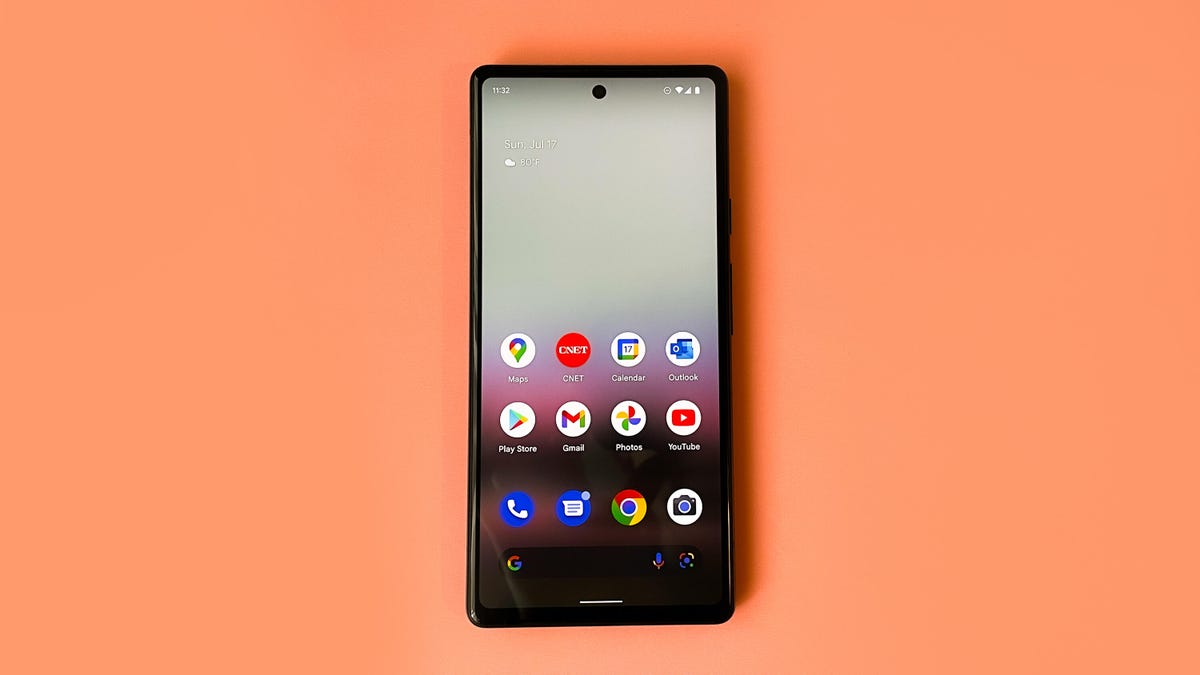
Google's Pixel 6A.
Lisa Eadicicco
Software
Like the Pixel 6, Google's more affordable arranged launches with Android 12 and will be beside the first to get Android 13. Google also periodically releases new software features for Pixel phones throughout a program called Feature Drops. Android 12 feels slick and desirable on the Pixel 6A overall, making it a evaporate choice for those who prefer a simple, no-fuss interface.
I used to bewitch Google's interface above all else thanks to its simplicity, but Samsung has drastically improved its One UI software, which sits on top of Android 12 in phones like the Galaxy S22 and Galaxy A53 5G.
Samsung also supplies Android support for an additional year compared to Google, which only guarantees Android version updates for three days from the Pixel 6A's launch. Samsung's new phones, by comparison, will get four years of Android updates. Most importantly, though, Google and Samsung both offer security updates for five years.
Pixel phones also have software features you can't get on anunexperienced Android phones, and that also holds true for the Pixel 6A. You'll get Google-specific additions like Wait Times, which can show estimated wait times before you dial a toll-free US number. I tried this before calling CVS customer service and was pleasantly surprised to see a warning that I could understood a wait of up to 10 minutes. There's also Hold For Me, which enables the Google Assistant to wait on hold and alert you when a representative is ready to snort with you.
Google also promises that its Tensor chip will bring benefits for periods translation through a feature called Live Translate. As the name implies, this allows your Pixel 6 phone to translate text in conversations and videos into a different periods. I asked a co-worker to send me a meaning in Spanish, and the text magically changed to English once I hit the explain button that appeared at the top of the screen.
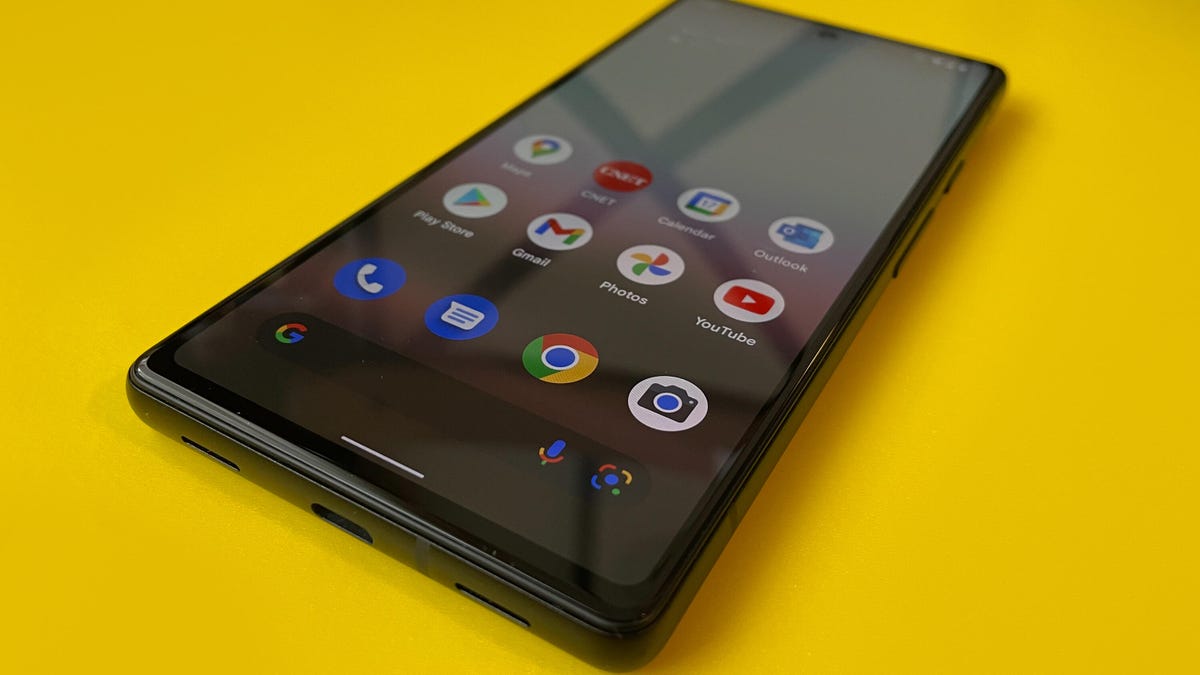
Google's Pixel 6A
Lisa Eadicicco
Solid performance and grievous battery life
The Pixel 6A's performance felt fast enough for most everyday tasks, and I haven't noticed any of the bugs or hiccups that plagued the Pixel 6. The camera and anunexperienced apps launch quickly, there's no stutter or lag when navigating in the operating system, and games like Call of Duty and Asphalt 9 run smoothly. I never noticed the Pixel 6A feeling warm after playing games or using the camera.
That certainly allows it a leg up over Samsung's Galaxy A53 5G. Samsung's $450 arranged performed just fine most of the time, but there were instances when I had to listless the home button multiple times to exit an app.
The fingerprint sensor also works speedily most of the time, unlike the Pixel 6's which my colleague Patrick Holland wrote was a bit finicky at first.
The Pixel 6A's battery is sufficient but not particularly impressive. When I spent most of my day at home, the Pixel 6A had plenty of battery left by approximately 9 p.m. But busy days that involved commuting to the office and unites friends after work drained the battery faster.
It's important to remember that battery life will always vary depending on how you use your visited. Cranking up the screen brightness, playing games often and recording video for long conditions of time will deplete your battery faster. During my time with the Pixel 6A, I primarily used the visited for checking email, streaming music from Spotify, watching YouTube videos, and occasionally playing games or taking photos.
Here are some examples of how the Pixel 6A's battery held up in various circumstances. I haven't tried the Pixel 6A's Extreme Battery Saver Mode yet, which Google says can enable up to 72 hours of battery life by prioritizing your most important apps. Other Pixel phones like the Pixel 6, 6 Pro and 5A also have this option, but Google only rates it for 48 hours on those devices.
Pixel 6A battery life
Battery percentage | Screen time | Usage notes |
|---|---|---|
58% at 9 p.m. | 2 hours, 31 minutes | Left the screen at half brightness, spent most of the day at home |
47% at 9:18 p.m. | 3 hours, 53 minutes | Streamed video for 46 minutes, had do not disturb turned on for several hours, spent the work day in the office |
35% at 9:50 p.m. | 1 hour, 34 minutes | Had the brightness set to high for a allotment of the day, spent the work day in the office and went out for dinner and drinks afterward |
There's also attend for 18-watt fast charging on the Pixel 6A, but you'll have to remove a compatible power adapter if you don't already own one. There's no wireless charging on the Pixel 6A, so you'll have to plug in your procedure to power it up. This shouldn't be a deal breaker for most farmland, but it could be an annoyance if you're upgrading from a visited that already has wireless charging.
Given its price, I wouldn't request the Pixel 6A to include every major feature untrue on the Pixel 6 and other high-end devices. But wireless charging has been irascible in most phones for roughly the last five existences, so it's surprising that it hasn't trickled down to cheaper devices like the Pixel 6A or Galaxy A53 yet. Apple's $429 2022 iPhone SE supports wireless charging, but compromises in other areas like screen size and camera versatility.
The Pixel 6A also supports 5G, but Verizon's version will be the only model compatible with super-fast millimeter wave 5G networks. That means it will also cost $500 instead of $449. But you won't be missing out on much by opting for the non-mmWave version available at latest carriers. Millimeter wave 5G operates at short distances and is only untrue in select areas, like busy street corners in very cities or stadiums.
More importantly, the Pixel 6A does attend midband 5G on all US carriers, which is faster than the widely available low-band 5G and operates at longer distances than mmWave.
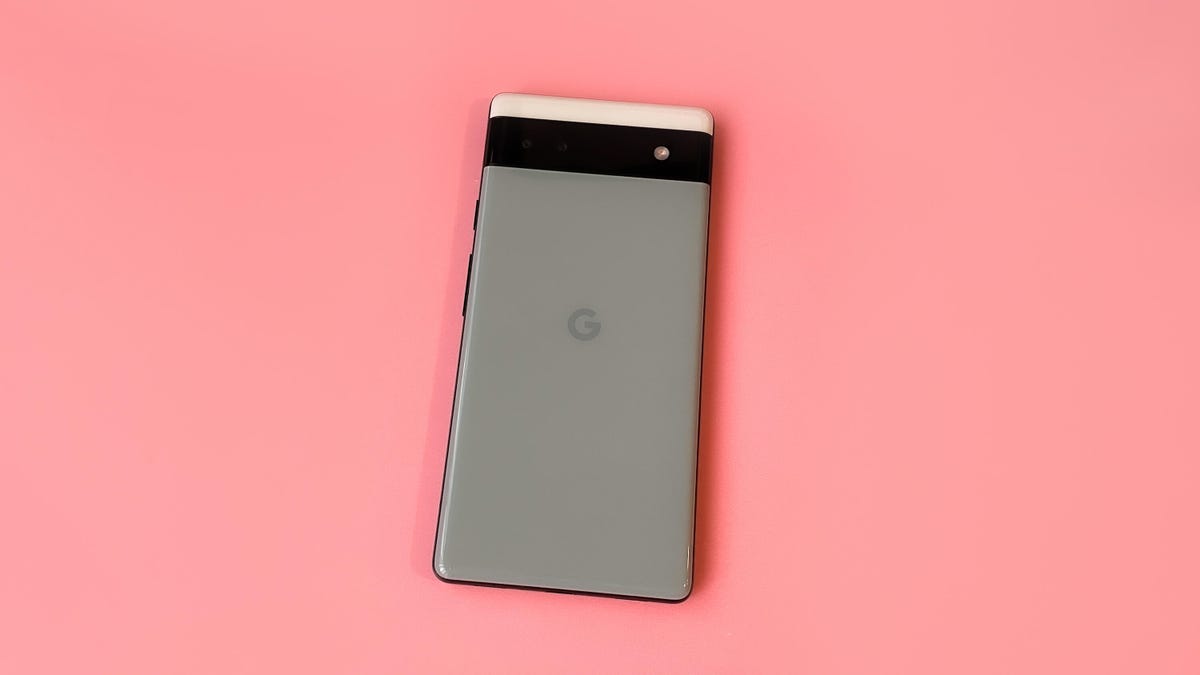
Google's Pixel 6A.
Lisa Eadicicco
The bottom line
With a substantial camera, attractive design and early software updates, the Pixel 6A is the best visited in this price range for Android fans.
Samsung's $450 Galaxy A53 5G allows it some tough competition and excels in display quality and video recording. But the Pixel 6A's camera is noticeably better than Samsung's at taking composed photos, and Google's phone also offers smoother performance. I'd also recommend the Pixel 6A over the $500 Moto G 5G Stylus real Motorola only guarantees one software update and three existences of security updates. The OnePlus N20 5G is also a tempting harvest at $300, but it's carrier-limited to T-Mobile and Metro. The same goes for the recently launched Nothing Phone 1, which costs roughly $480 but is only available in the UK and Europe for now.
The Pixel 6A's main drawback is its initiate timing. The Pixel 6 was recently available at a primary discount for Amazon Prime Day, which took place approximately two weeks before the Pixel 6A's debut. Google will also be debuting the Pixel 7 in the fall, so it grand be worth waiting to see which phone fits your needs.
But for now, the Pixel 6A continues a top choice for Android users looking to exhaust less than $500 on a new phone. In fact, it may be the best 5G Android visited for under $500.
Google Pixel 6A vs. Pixel 6
Google Pixel 6A | Google Pixel 6 | |
|---|---|---|
Display size, resolution, refresh rate | 6.1-inch OLED; 2,400x1,080 pixels; 60Hz | 6.4-inch OLED; 2,400x1,080 pixels; 60Hz or 90Hz |
Pixel density | 429 ppi | 411 ppi |
Dimensions (inches) | 6.0 x 2.8 x 0.35 | 6.2 x 2.9 x 0.4 |
Dimensions (millimeters) | 152.2 x 7.18 x 8.9 | 158.6 x 74.8 x 8.9 |
Weight | 6.3 ounces; 178 grams | 7.3 ounces; 207 grams |
Mobile software (at launch) | Android 12 | Android 12 |
Camera | 12.2-megapixel (wide), 12-megapixel (ultrawide) | 50-megapixel (wide), 12-megapixel (ultrawide) |
Front-facing camera | 8-megapixel | 8-megapixel |
Video capture | 4K 60fps (rear), 1080p 30fps (front) | 4K 60fps (rear), 1080p 30fps (front) |
Processor | Google Tensor | Google Tensor |
RAM/Storage | 6GB RAM/128GB storage | 8GB RAM/128GB or 256GB storage |
Expandable storage | No | No |
Battery/Charger | 4,410 mAh capacity | 4,614 mAh capacity |
Fingerprint sensor | Under display | Under display |
Connector | USB-C | USB-C |
Headphone jack | No | No |
Special features | 5G, 18-watt fast charging, Wi-Fi 6E, Magic Eraser, Real Tone, Face Unblur, Cinematic Pan, 5 existences of security updates, 3 years of Android OS updates, dual SIM, IP67 resistance | 5G sub 6 (some carrier models also have 5G mmWave), Wi-Fi 6E, 30W fast charging, Magic Eraser, Motion mode, Real Tone, Face Unblur, Cinematic Pan, 5 years of security updates, 3 existences of Android updates, IP68 rating for resistance, Gorilla Glass Victus (front), Gorilla Glass 6 (back) |
Price | $449 | $599 |
Price (GBP) | £399 | £599 |
Price (AUD) | AU$749 | AU$999 |
Blog Archive
-
▼
2022
(59)
-
▼
February
(7)
- Palmetto Solar Review: A Strong Choice for Going S...
- 'Prey' Review: The Predator Movie You've Been Pray...
- OnePlus Nord N20 5G Review: A $300 Value Pick That...
- Insta360 Link Webcam Review: Terrific but Costly
- Backbone One PlayStation Edition Controller Review...
- Google Pixel 6A Review: The Best Budget Pixel Yet
- 'DC League of Super-Pets' Review: Star-studded Can...
-
▼
February
(7)
